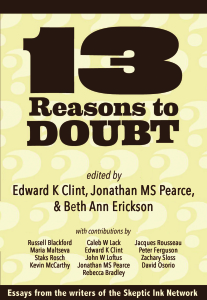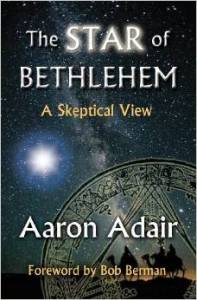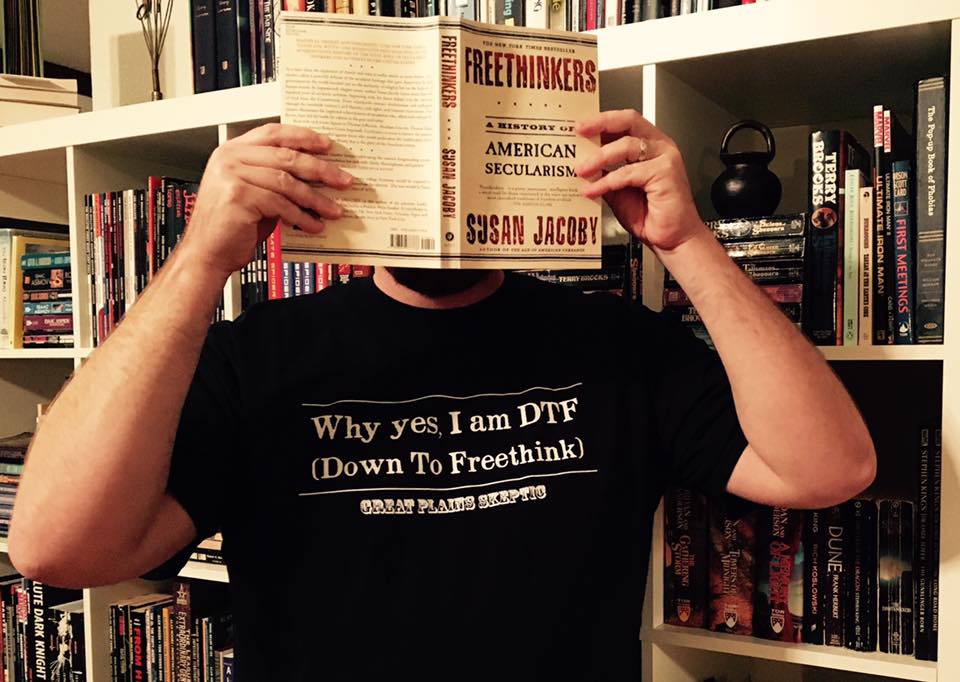Despite the fact that most scientific skeptics do not find themselves formerly associated with a religion, this time of year tends to nonetheless bring out the giving spirit in many of us. Although Tom Flynn wouldn’t approve, many of us celebrate (in a secular fashion) Christmas, or Kwanza, or Festivus, or the Solstice, or Hanukkah, or just like to give presents because it’s fun. With that in mind, I’ve linked below some potential gifts that many a person reading this might want to either give or receive. Each is (in part or whole) the work of one of the Skeptic Ink Network’s fine writers, so you’re not just giving a great gift, you’re helping out a great person.
First up is the first official GPS merchandise, a high quality, screen printed t-shirt that says “Why yes, I am DTF (Down To Freethink).” My friend Austin used this phrase, and I thought it was hilarious and needed to be on a shirt, so we teamed up to bring it to you! These are guaranteed to cause a stir amongst your friends and family around the holidays, as you both explain to them what DTF traditionally means and what a freethinker is.
We have sizes S-XL available for $15 each (plus shipping costs), and a limited quantity of 2XL and 3XL available for $20 each. If you would like one, shoot me an email at professor.lack[at]gmail[dot]com and I can get you hooked up in time for a very awkward holiday dinner or two!
 Next is my latest book, Obsessive-Compulsive Disorder: Etiology, Phenomenology, and Treatment. It’s an introduction to introduction to the fascinating world of those with problematic obsessions and compulsions. Easily readable by both people in the field and those with family members who suffer from OCD, it’s been called ” a terrific volume on OCD that is concise yet thorough.”
Next is my latest book, Obsessive-Compulsive Disorder: Etiology, Phenomenology, and Treatment. It’s an introduction to introduction to the fascinating world of those with problematic obsessions and compulsions. Easily readable by both people in the field and those with family members who suffer from OCD, it’s been called ” a terrific volume on OCD that is concise yet thorough.”
Buy e-copies or hard copies online at Amazon, Barnes & Noble, and Kobo!
 Then we have 13 Reasons to Doubt
Then we have 13 Reasons to Doubt, the first book from the Skeptic Ink Network. It contains 13 chapters by various SIN bloggers (including myself) and has received quite positive reviews in the press. As I said when it was released:
…this is a very solid book. The topics are very wide ranging (as befits the diversity of the authors) and covers topics outside of the “typical” skeptical ones (e.g., what some people deride as “Bigfoot skepticism”). Instead, you have philosophers, archaeologists, psychologists, anthropologists and more discussing topics from why skepticism is important to cognitive biases to science denialism and more. My personal favorite chapters are those by Russell Blackford and Jacques Rousseau, who both happen to be philosophers and skeptics.
 Next (because, after all, I’m the one doing this) is another of my books – Psychology Gone Astray: A Selection of Racist & Sexist Literature from Early Psychological Research
Next (because, after all, I’m the one doing this) is another of my books – Psychology Gone Astray: A Selection of Racist & Sexist Literature from Early Psychological Research. As I said in an interview about the book’s release:
The book addresses an often-ignored issue in psychology: how the results of numerous poorly conducted psychological studies were used to support and justify both scientific and institutionalized sexism and racism….If we do not learn how to spot such dubious research and results, we will likely fall prey to such problems again and again.
I also talked about what we uncovered in our examination of early psychological research in a podcast with the Blue Ball Skeptics, or you can read a sample in this previous post. If you’d like to get any of my other books (with me as solo author or contributing a chapter), just head over to my Amazon author page.
 Switching things up a bit, my good friend Jonathan Pearce, who blogs at A Tippling Philosopher, has published a couple of good books over the past year or so. His latest ebook is The Problem with “God”: Classical Theism under the Spotlight. It’s a great introduction to philosophy of religion and non-religion and isn’t the condescending tone often encountered in online debates or write-ups, but instead a thoughtful, well-written collection.
Switching things up a bit, my good friend Jonathan Pearce, who blogs at A Tippling Philosopher, has published a couple of good books over the past year or so. His latest ebook is The Problem with “God”: Classical Theism under the Spotlight. It’s a great introduction to philosophy of religion and non-religion and isn’t the condescending tone often encountered in online debates or write-ups, but instead a thoughtful, well-written collection.
Pearce is also the co-editor of a wonderful collection of essays titled Beyond an Absence of Faith: Stories about the Loss of Faith and Discovery of Self. As I said in my review of the book when it came out:
Pearce and Vick have brought together a diverse group of voices with one thing in common – they have moved beyond being “former believers” into being active participants in humanity. Each of the stories shared is unique, but former believers will find something they can identify with in every one. From the pain of separation from friends and family, to the joy of being liberated from a sexist mindset, to the harsh reality of having to find a new career in the middle of your life because you have embraced reason, these personal stories help to reinforce for the non-believer that you are not alone in your journey. Instead, you are walking a path many have gone down before, and you can take solace in knowing that these authors have been there as well.
 Next up is The Star of Bethlehem: A Skeptical View
Next up is The Star of Bethlehem: A Skeptical View by Aaron Adair (who often writes for the A Tippling Philosopher blog on SIN). As I said when I reviewed it:
Adair writes in clear, concise prose, which is very helpful when you are reading about a scientific field that you have little to no training in. My formal experience with astronomy is minimal, although I do own a telescope and host the occasional star-gazing party…. Nonetheless, despite my ignorance of the field, I never felt lost or confused when reading SOB.
Adair is a clean writer, without the superfluousness that sometimes plagues writers early in their career. In terms of content, Adair does a great job at covering all bases. The book is broadly divided into three sections (The Story, The Hypotheses, and Fatal Problems), with the majority of the book examining the specific natural hypotheses that have been proposed over the centuries to explain the story of the Star as told in the Gospel of Matthew (and only that particular gospel, something many people don’t know).
I n addition, also in the spirit of the season, Jonathan Pearce (mastermind behind ATP) has a book entitled The Nativity: A Critical Examination
n addition, also in the spirit of the season, Jonathan Pearce (mastermind behind ATP) has a book entitled The Nativity: A Critical Examination that does a very thorough job collating the various scholarship on aspects of the Nativity story that we are familiar with (and yet, which doesn’t actually appear in any of the gospels). From the back of the book:
The nativity of Jesus is an event that carries much cultural recognition. However, is it a narrative which commands much support in the academic world? Is it a story which holds much historical truth? Or were the two biblical accounts of the birth of Jesus an opportunity for the authors to impart a theological truth or otherwise?
These are the sort of questions that are often asked of the nativity accounts and questions which are answered in this concise and yet well-researched and informative book. Some twenty arguments are looked at and presented in a clear and detailed manner, building a cumulative case for the objection to the historical nature of the Gospel accounts. The author also questions what purpose these stories do serve if indeed they do carry little or no historical truth.
With reference to a wide array of contemporary and iconic works on the subject, Pearce has created a compendium of critical arguments against the historicity of a story which still remains a vital piece of our collective cultural and religious tapestry.
And, if you’re just too broke to buy anything but still have access to a printer and ink, you could always just make and hand out these amazing Carl Sagan / Skeptic Ink papercrafts!


